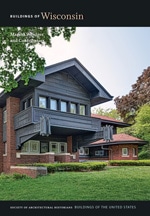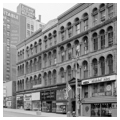The Iron Block, Milwaukee’s sole surviving cast-iron-front commercial building, recalls America’s first substantial attempt at prefabricated architecture: the mass production of cast-iron decorative panels. Between the late 1840s and the early 1870s, cast iron formed many storefronts and commercial buildings. The material was strong, durable, fire-resistant, and capable of being molded into various decorative shapes and textures. When painted, it could simulate carved stone. More important, cast-iron panels made in a distant foundry could be shipped almost anywhere in the country, eliminating the need for skilled artisans such as stonemasons on the construction site. Cast-iron designs permitted remote American towns to erect buildings as ornate as those in the nation’s largest cities.
The Iron Block was a speculative venture for James Martin, an early settler, who had the cast-iron front shipped by boat from Daniel Badger’s Architectural Iron Works in New York City. Martin had the front installed on a timber and brick building skeleton. The building features rusticated walls, rows of round-arched windows, and Corinthian columns. Piers at the corners and between the bays are made of vermiculated blocks topped with a lion’s head. Originally called the Excelsior Block after the Excelsior Lodge of Masons who occupied the top floor, the structure was extensively altered at the shop-front level, but it was restored in 1984 to its original appearance.





